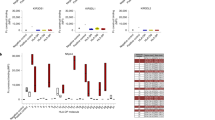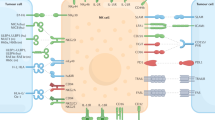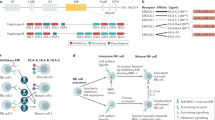Abstract
Natural killer (NK) cells attack tumor and infected cells, but the receptors and ligands that stimulate them are poorly understood. Here we report the expression cloning of two murine ligands for the lectin-like receptor NKG2D. The two ligands, H-60 and Rae1β, are distant relatives of major histocompatibility complex class I molecules. NKG2D ligands are not expressed by most normal cells but are up-regulated on numerous tumor cells. We show that mouse NKG2D is expressed by NK cells, activated CD8+ T cells and activated macrophages. Expression of either NKG2D ligand by target cells triggers NK cell cytotoxicity and interferon-γ secretion by NK cells, as well as nitric oxide release and tumor necrosis factor α transcription by macrophages. Thus, through their interaction with NKG2D, H-60 and Rae1β are newly identified potent stimulators of innate immunity.
This is a preview of subscription content, access via your institution
Access options
Subscribe to this journal
Receive 12 print issues and online access
$209.00 per year
only $17.42 per issue
Buy this article
- Purchase on Springer Link
- Instant access to full article PDF
Prices may be subject to local taxes which are calculated during checkout







Similar content being viewed by others
References
Trinchieri, G. Biology of natural killer cells. Adv. Immunol. 47, 187–376 (1989).
Ljunggren, H.G. & Karre, K. In search of the ‘missing self’: MHC molecules and NK cell recognition. Immunol. Today 11, 237–244 (1990).
Lanier, L.L. NK cell receptors. Annu. Rev. Immunol. 16, 359–393 (1998).
Vitale, M. et al. NKp44, a novel triggering surface molecule specifically expressed by activated natural killer cells, is involved in non-major histocompatibility complex-restricted tumor cell lysis. J. Exp. Med. 187 , 2065–2072 (1998).
Sivori, S. et al. NKp46 is the major triggering receptor involved in the natural cytotoxicity of fresh or cultured human NK cells. Correlation between surface density of NKp46 and natural cytotoxicity against autologous, allogeneic or xenogeneic target cells. Eur. J. Immunol. 29, 1656–66 (1999).
Pende, D. et al. Identification and molecular characterization of NKp30, a novel triggering receptor involved in natural cytotoxicity mediated by human natural killer cells. J. Exp. Med. 190, 1505– 16 (1999).
Miyazaki, T., Dierich, A., Benoist, C. & Mathis, D. Independent modes of natural killing distinguished in mice lacking Lag3. Science 272, 405–8 ( 1996).
Ryan, J., Niemi, E., Nakamura, M. & Seaman, W. NKR-P1A is a target-specific receptor that activates natural killer cell cytotoxicity. J. Exp. Med. 181, 1911–1915 ( 1995).
Brown, M.H. et al. 2B4, the natural killer and T cell immunoglobulin superfamily surface protein, is a ligand for CD48. J. Exp. Med. 188, 2083–90 (1998).
Houchins, J.P., Yabe, T., McSherry, C., Miyokawa, N. & Bach, F.H. Isolation and characterization of NK cell or NK/T cell-specific cDNA clones. J. Mol. Cell. Immunol. 4 , 295–304, 305–6 (1990).
Houchins, J.P., Yabe, T., McSherry, C. & Bach, F.H. DNA sequence analysis of NKG2, a family of related cDNA clones encoding type II integral membrane proteins on human natural killer cells. J. Exp. Med. 173, 1017–20 (1991).
Vance, R.E., Jamieson, A.M. & Raulet, D.H. Recognition of the class Ib molecule Qa-1(b) by putative activating receptors CD94/NKG2C and CD94/NKG2E on mouse natural killer cells . J. Exp. Med. 190, 1801– 12 (1999).
Lazetic, S., Chang, C., Houchins, J.P., Lanier, L.L. & Phillips, J.H. Human natural killer cell receptors involved in MHC class I recognition are disulfide-linked heterodimers of CD94 and NKG2 subunits. J. Immunol. 157, 4741 –4745 (1996).
Wu, J. et al. An activating immunoreceptor complex formed by NKG2D and DAP10 . Science 285, 730–2 (1999).
Bauer, S. et al. Activation of NK cells and T cells by NKG2D, a receptor for stress-inducible MICA. Science 285, 727– 9 (1999).
Groh, V. et al. Cell stress-regulated human major histocompatibility complex class I gene expressed in gastrointestinal epithelium. Proc. Natl Acad. Sci. USA 93, 12445–50 (1996).
Groh, V. et al. Broad tumor-associated expression and recognition by tumor-derived γδ T cells of MICA and MICB. Proc. Natl Acad. Sci. USA 96, 6879–84 (1999).
Crowley, M.P. et al. A population of murine γδ T cells that recognize an inducible MHC class Ib molecule. Science 287, 314–6 (2000).
Crowley, M.P., Reich, Z., Mavaddat, N., Altman, J.D. & Chien, Y. The recognition of the nonclassical major histocompatibility complex (MHC) class I molecule, T 10, by the γδ T cell, G8. J. Exp. Med. 185, 1223–30 (1997).
Bahram, S., Bresnahan, M., Geraghty, D.E. & Spies, T. A second lineage of mammalian major histocompatibility complex class I genes . Proc. Natl Acad. Sci. USA 91, 6259– 63 (1994).
Ho, A.S. et al. A receptor for interleukin 10 is related to interferon receptors . Proc. Natl Acad. Sci. USA 90, 11267– 71 (1993).
Malarkannan, S. et al. The molecular and functional characterization of a dominant minor H antigen, H60. J. Immunol. 161, 3501 –9 (1998).
Nomura, M., Takihara, Y. & Shimada, K. Isolation and characterization of retinoic acid-inducible cDNA clones in F9 cells: one of the early inducible clones encodes a novel protein sharing several highly homologous regions with a Drosophila polyhomeotic protein. Differentiation 57, 39– 50 (1994).
Nomura, M. et al. Genomic structures and characterization of Rae1 family members encoding GPI-anchored cell surface proteins and expressed predominantly in embryonic mouse brain. J. Biochem. 120, 987–95 (1996).
Zou, Z., Nomura, M., Takihara, Y., Yasunaga, T. & Shimada, K. Isolation and characterization of retinoic acid-inducible cDNA clones in F9 cells: a novel cDNA family encodes cell surface proteins sharing partial homology with MHC class I molecules. J. Biochem. 119, 319–28 ( 1996).
Vance, R.E., Tanamachi, D.M., Hanke, T. & Raulet, D.H. Cloning of a mouse homolog of CD94 extends the family of C-type lectins on murine natural killer cells. Eur. J. Immunol. 27, 3236–3241 (1997).
Ho, E.L. et al. Murine Nkg2d and Cd94 are clustered within the natural killer complex and are expressed independently in natural killer cells. Proc. Natl Acad. Sci. USA 95, 6320– 6325 (1998).
Hong, W.K. & Sporn, M.B. Recent advances in chemoprevention of cancer. Science 278, 1073– 7 (1997).
Amadou, C. et al. The mouse major histocompatibility complex: some assembly required. Immunol. Rev. 167, 211– 21 (1999).
Cosman, D. et al. The human cytomegalovirus (HCMV) glycoprotein, UL16, binds to the MHC class I-related protein, MICB/PERB11, and to two novel, MHC class I-related molecules, ULBP1 and ULBP2. FASEB J. 14, A1018 (2000).
Chalupny, J. et al. Soluble forms of the novel MHC class I–related molecules, ULBP1 and ULBP2, bind to, and functionally activate NK cells. FASEB J. 14, A1018 (2000).
Vance, R.E., Kraft, J.R., Altman, J.D., Jensen, P.E. & Raulet, D.H. Mouse CD94/NKG2A is a natural killer cell receptor for the nonclassical MHC class I molecule Qa-1b. J. Exp. Med. 188, 1841–1848 (1998).
Altman, J.D. et al. Phenotypic analysis of antigen-specific T lymphocytes. Science 274, 94–6 ( 1996).
Elliott, J.F. et al. Genes for Plasmodium falciparum surface antigens cloned by expression in COS cells. Proc. Natl Acad. Sci. USA 87, 6363–7 (1990).
Hirt, B. Selective extraction of polyoma DNA from infected mouse cell cultures. J. Molec. Biol. 26, 365–369 (1967).
Kang, J. et al. T cell receptor γ gene regulatory sequences prevent the function of a novel TCRγ/p Tα pre-T cell receptor. Immunity 8, 713–721 ( 1998).
Diefenbach, A. et al. Type 1 interferon (IFNαβ) and type 2 nitric oxide synthase regulate the innate immune response to a protozoan parasite. Immunity 8, 77–87 ( 1998).
Förster, E. An improved general method to generate internal standards for competitive PCR. Biotechniques 16, 18– 20 (1994).
Hanke, T. et al. Direct assessment of MHC class I binding by seven Ly49 inhibitory NK cell receptors. Immunity 11, 67– 77 (1999).
Ranganath, S. et al. GATA-3–dependent enhancer activity in IL-4 gene regulation . J. Immunol. 161, 3822– 6 (1998).
Pear, W.S., Nolan, G.P., Scott, M.L. & Baltimore, D. Production of high-titer helper-free retroviruses by transient transfection. Proc. Natl Acad. Sci. USA 90, 8392– 6 (1993).
Acknowledgements
We thank R.E.Vance and C.W. McMahon for advice and comments on the manuscript, J. Egen for help with the immunofluorescence staining, H. Nolla for cell sorting, C.White for expert technical assistance, J.F. Elliott, M. Fasso, L. Mendoza for their gifts of reagents and cell lines. Supported by grants from the National Institute of Health (D.H.R.) and the Deutsche Forschungsgemeinschaft (A.D.). A.D. is a Physician Postdoctoral fellow of the Howard Hughes Medical Institute.
Author information
Authors and Affiliations
Corresponding author
Rights and permissions
About this article
Cite this article
Diefenbach, A., Jamieson, A., Liu, S. et al. Ligands for the murine NKG2D receptor: expression by tumor cells and activation of NK cells and macrophages. Nat Immunol 1, 119–126 (2000). https://doi.org/10.1038/77793
Received:
Accepted:
Issue Date:
DOI: https://doi.org/10.1038/77793
This article is cited by
-
Bystander activated CD8+ T cells mediate neuropathology during viral infection via antigen-independent cytotoxicity
Nature Communications (2024)
-
Roles of natural killer cells in immunity to cancer, and applications to immunotherapy
Nature Reviews Immunology (2023)
-
Comparison of cytotoxic potency between freshly cultured and freshly thawed cytokine-induced killer cells from human umbilical cord blood
Cell and Tissue Banking (2023)
-
CSPG4 CAR-redirected Cytokine Induced Killer lymphocytes (CIK) as effective cellular immunotherapy for HLA class I defective melanoma
Journal of Experimental & Clinical Cancer Research (2023)
-
Modified dendritic cell-derived exosomes activate both NK cells and T cells through the NKG2D/NKG2D-L pathway to kill CML cells with or without T315I mutation
Experimental Hematology & Oncology (2022)



